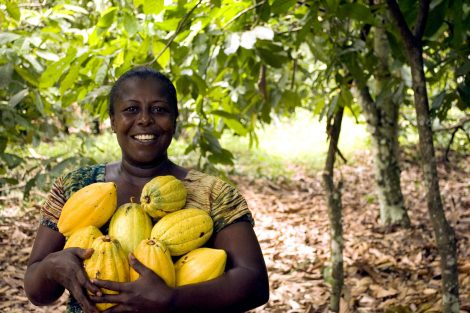Cocoa has been part of the Cuban landscape for centuries and a certain tradition and popular culture emerged around it. Numerous drinks have emerged, marked by the different waves of migration. It is a way, as in the case of chocolate bars, to celebrate special events, as well as to start or end another day of work.
Baracoa represents around 75% of the country’s cocoa production with around 2,500 people working for it on more or less 4,000 hectares. The cultivated area of the region is slightly less than 20,000 hectares and the population is slightly more than 80,000 inhabitants.
Cocoa cultivation takes place mainly on small family farms where the pods are harvested and opened, marketing the mucilage through the Agroforestry Company. Carrying out fermentation and drying in Company facilities.
The harvest should be only of the ripe fruits. Green ears contain immature grains that give the product a bad taste and aroma. For harvests, the maturity of the ears and the presence of pests, diseases or harmful animals must be considered. When the quantity of ripe fruits is abundant and there are health and pest problems, the frequency of harvesting must be increased in order to avoid losses.
On small or medium-sized farms, the harvesting of ears should be done every two or three weeks, thereby avoiding overripeness of the fruits and the risk of losses. Appropriate tools must be used for harvesting, the main one being pruning shears, the cut of which must be made near the ear and not on the floral cushion, as it can also damage it, detrimental to the future harvest; Any other tool, such as the machete, can cause wounds to the tree or damage the fruit kernels. Under no circumstances should you pluck the ears by pulling them with your hand, because it tears and completely destroys the floral cushion, causing dangerous injuries to the trunk.
Generally, the piles of fruits should be made in a space without cocoa trees and in which the work of splitting the pods can be easily carried out and where it is possible to gather the shells for their decomposition and subsequent use in the same crop, as fertilizer. very good quality organic.
Due to its characteristics, it demands labor, which in many cases is provided by the family, and in some cases workers or labor specialized in key tasks for the development of the crop are hired. This quality makes it an important producer of both direct and indirect employment; It is estimated that in the management and support phase, for every three hectares of cocoa, one permanent rural job is generated. For this reason, it is considered that this crop energizes the economy of the areas in which cocoa projects are developed, which, in addition, in many cases, are located in regions that present various social problems such as poverty, unemployment, violence, among others. .
For weed control, the use of plant covers is one of the most used mechanisms in agroecology. It is a sustainable alternative for controlling weeds, reducing runoff, preventing erosion, and contributing to the improvement of the physical characteristics of the soil such as: porosity, structure, texture, water infiltration into the soil, increasing the nitrogen content. ; chemicals such as: phosphorus, potassium and other microelements; and biological aspects of the soil since they contribute to the development of microfauna when decomposing. Manual control is another of the mechanisms most used by producers to eliminate weeds from the soil.
Cocoa begins its production after three years and can be grown in any type of soil from sandy loam to heavy clays and by being managed with agroecological techniques we protect the environment, reduce vulnerability and adapt better to climate change.
Among the main properties of cocoa, we can mention its antioxidant property, rich in polyphenol antioxidants. It is beneficial for the heart, because if dark chocolate is consumed daily and in small quantities, it reduces the risk of suffering a heart attack. It has a great anti-cancer, brain-stimulating, anti-tussive and anti-diarrheal effect.
The cocoa industry in Cuba has a wide possibility of development. Therefore, it is necessary to continue strengthening the use of technologies that are adapted to the region and that guarantee an improvement in production processes. This could contribute to improving production levels, increasing product quality and access to better markets. Carrying out research and training of the different links involved in this productive chain promotes the growth of the cocoa sector and the development of alternatives for the industry. This could also contribute to the economic stability of the sectors involved in the production, processing and marketing of cocoa.
Quality markets have a growing interest in finding high-quality cocoa, with special flavors and origins. Cuba’s cocoa production is becoming one of the most important targets for export businesses. It is a goal of the Baracoa cocoa sector to be recognized worldwide for its marked aroma and color characteristics, highly appreciated in the preparation of fine chocolates, coatings and couvertures. Due to the interest shown by the international market, we seek to improve cocoa production to fully satisfy a future increase in demand.

